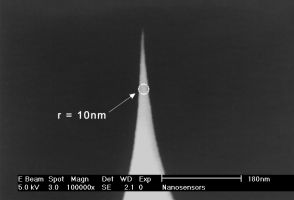Szabo GL, Jany BR, Muckenhuber H, Niggas A, Lehner M, Janas A, Szabo PS, Gan Z, George A, Turchanin A, Krok F
Charge‐State‐Enhanced Ion Sputtering of Metallic Gold Nanoislands
Small. 2023 Jun;19(26):2207263
DOI: https://doi.org/10.1002/smll.202207263
Paul A, Rayabharam A, Murkute P, Almonte L, Rigo E, Dong Z, Kumar A, Joseph J, Aluru N, Timp G
Decoding Proteoforms with Single Acid Resolution Using a Sub-nanometer Diameter Pore
bioRxiv. 2022 Dec 22:2022-12
DOI: https://doi.org/10.1101/2022.12.22.521660
Sarveswaran K, Kurz V, Dong Z, Tanaka T, Penny S, Timp G
Synthetic capillaries to control microscopic blood flow
Scientific reports. 2016 Feb 24;6(1):21885
DOI: https://doi.org/10.1038/srep21885
Harte NP, Klyubin I, McCarthy EK, Min S, Garrahy SA, Xie Y, Davey GP, Boland JJ, Rowan MJ, Mok KH
Amyloid oligomers and mature fibrils prepared from an innocuous protein cause diverging cellular death mechanisms.
Journal of Biological Chemistry. 2015 Nov 20;290(47):28343-52
DOI: https://doi.org/10.1074/jbc.M115.676072
Mücke N, Kirmse R, Wedig T, Leterrier JF, Kreplak L.
Investigation of the morphology of intermediate filaments adsorbed to different solid supports
Journal of structural biology. 2005 Jun 1;150(3):268-76
DOI: https://doi.org/10.1016/j.jsb.2005.02.012






 Due to their unique geometry the tips of the are more susceptible to tip damage by electrostatic discharge (ESD) than other Silicon-SPM-Probes.
Due to their unique geometry the tips of the are more susceptible to tip damage by electrostatic discharge (ESD) than other Silicon-SPM-Probes.
